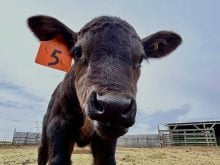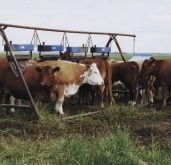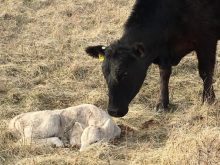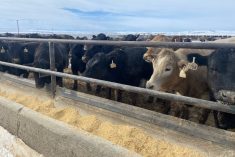The last trimester is a very critical time for the average beef cow and her unborn calf. Her unborn calf gains about three-quarters of its birth weight during this period, dramatically increasing all her primary nutrient requirements. While feeding better-quality forages together with a few more pounds of grain and protein supplement tend to cover off extra energy and protein needs, the smallest trace mineral demand contained in the cow’s diet often gets overlooked, yet it is just as important.
Assurance of good trace mineral status in pre-calving cows benefits the upcoming calving season — getting newborn calves off to a good start and allowing these mothers to be successfully rebred and settled back in the herd with next year’s calf crop.
Read Also

Harvest wraps up and fall work begins
At the Eppich famly ranch in western Saskatchewan, the fall harvest was successful with few breakdowns, cows and calves have been sorted and a new tractor has arrived
While both the cow and fetus need a good pre-calving trace mineral-feeding program, science seems to dictate the fetus takes a slight priority over the dam’s trace mineral needs. Research shows trace mineral-deficient beef cows have been actually deplete their own limited trace mineral reserves, before their calves become mineral deficient and thus adversely affected. It is estimated the late-gestation fetus (and placental tissues) utilize up to 30 per cent of the pre-calving cow’s daily requirements for essential trace minerals.
UNHEALTHY CALVES
Unfortunately, fetal calves from mineral-deficient cows will eventually become marginal/severely trace mineral-deficient themselves and will be affected. For example, a classic case of a selenium deficiency in a brood cow herd illustrates this point: selenium is one of the essential trace minerals that easily cross the placenta. Therefore good dietary selenium supplementation to the pre-calving cow diet increases the selenium body reserves in cows and transfers it to their fetal calves. In contrast, failure to maintain adequate selenium status in pregnant beef cows leads to a greater incidence of typical white muscle disease, greater susceptibility to infectious disease and poor growth, once these calves are born.
Even before new calves hit the ground, poor trace mineral status can haves a significant negative impact upon the brood cows themselves; namely their ability to get rebred.
Although, it is not fully understood, the essential trace mineral status of late-gestation cows, impacts their normal reproductive hormone production as well as follicular development on the cow’s ovaries. It is estimated that eggs begin maturing about 100 days before they are produced and released. Some beef reproductive specialists speculate good cow fertility is impacted by the amount and different types of nutrients/trace minerals needed during the pre-calving period.
From the Canadian Cattlemen website: The Top 10 list to an easier calving season
PROPER MANAGEMENT
It’s good evidence that trace minerals are needed just before calving. Assuring all essential trace mineral requirements for late-gestation cows are met really becomes a simple matter of feeding a well-balanced commercial mineral containing supplemental copper, manganese, zinc, iodine, cobalt, and selenium. The following nutrition and management suggestions also help in making sure late gestation beef cows receive enough trace minerals:
- Target cow herd mineral consumption. Target a daily consumption of 50-100 grams. If the cow herd is not eating enough or too much, add one-third portion salt to the mineral mixture. On occasion, calculate the average mineral intake of the herd, and make the necessary adjustment for adequate and consistent mineral consumption.
- Know the dietary sources in your mineral. This is particularly important when purchasing cattle mineral. Knowing the copper final concentration of your cows’ diet without knowing the source of supplemental copper is of little value. For example, copper comes in many forms such as copper oxide, copper sulphate, and chelated (organic) copper forms, which have relative biological availabilities of five per cent, 100 per cent , and 125-150 per cent.
- Feed a “beef breeder mineral” all winter long. Some producers feed a more fortified commercial mineral (with more biologically available organic copper, zinc, manganese and selenium) all winter. They say the cost difference between a basic gestation and a pre-calving “beef breeder mineral” calculates to a $3 to $4 per head premium over the first half of the winter, yet it is worth the assurance of good trace mineral status for the entire late-gestating herd until the calving.
- Fill your mineral feeders on a regular basis. Mineral feeders should be filled every two to three days and hardened old mineral should be removed. It’s also important to remove snow and debris that prevents good mineral consumption.
- Know how to calculate your daily mineral and seasonal costs. This point should not be confused with whether one spends too little or too much money on their mineral feeding program! A beef cow breeder mineral worth $40 per 25-kg feed at 75 grams per day costs approximately 12 cents per head per day. Fed for a 90 day pre-calving period costs about $11 per beef cow.
- Avoid feeding too much trace minerals. The old adage of “one spoonful of medicine is good, two spoonfuls of medicine is better” simply does not work when building or maintaining adequate mineral status in beef cows.
For example: With a suspected copper deficiency in a cow herd, note the symptoms of marginal copper deficiency is very similar to those of a marginal copper toxicity. Consult with your beef specialist or veterinarian for trace mineral nutrition advice.
Setting up a good pre-calving trace mineral-feeding program is often a matter of fine-tuning the current mineral program that was started a few months ago. It can be as simple as switching from a standard to more fortified beef breeder mineral in order to meet the higher trace mineral (and vitamin) requirements of the late-gestation beef cow.
Peter Vitti is an independent livestock nutritionist and consultant based in Winnipeg. To reach him call 204-254-7497 or by email at [email protected].















